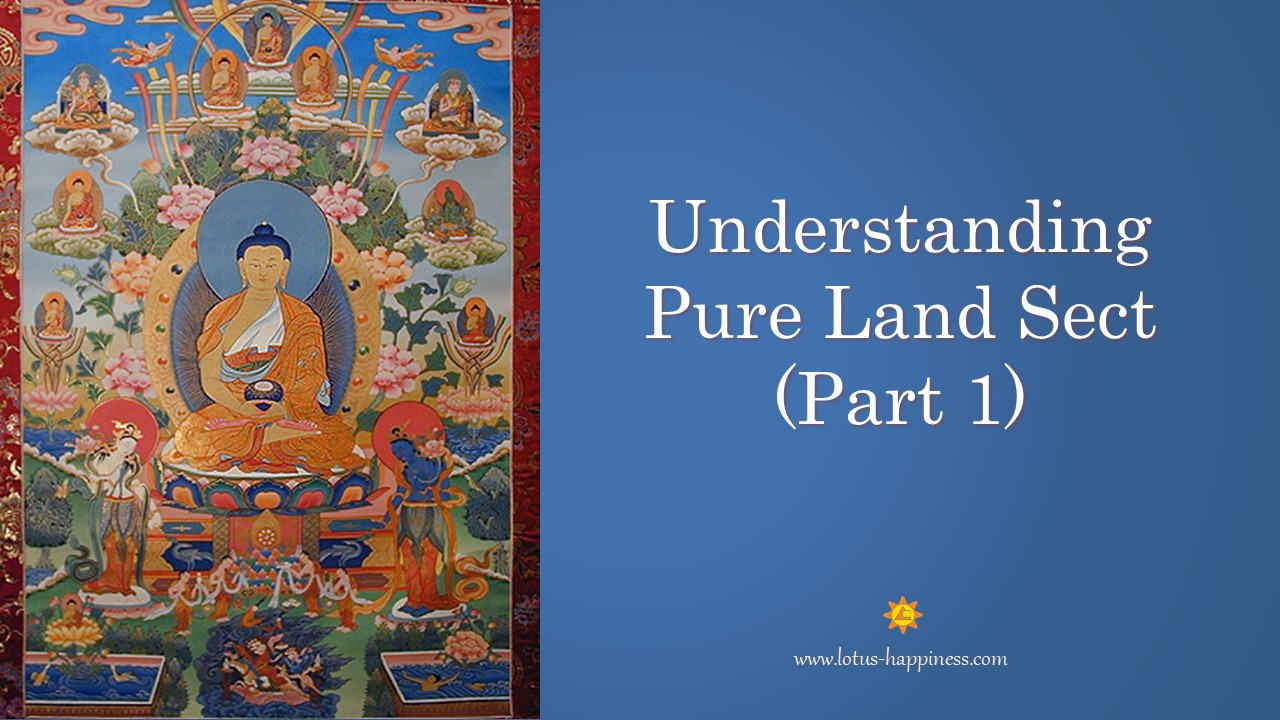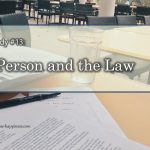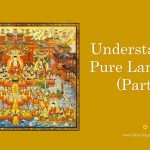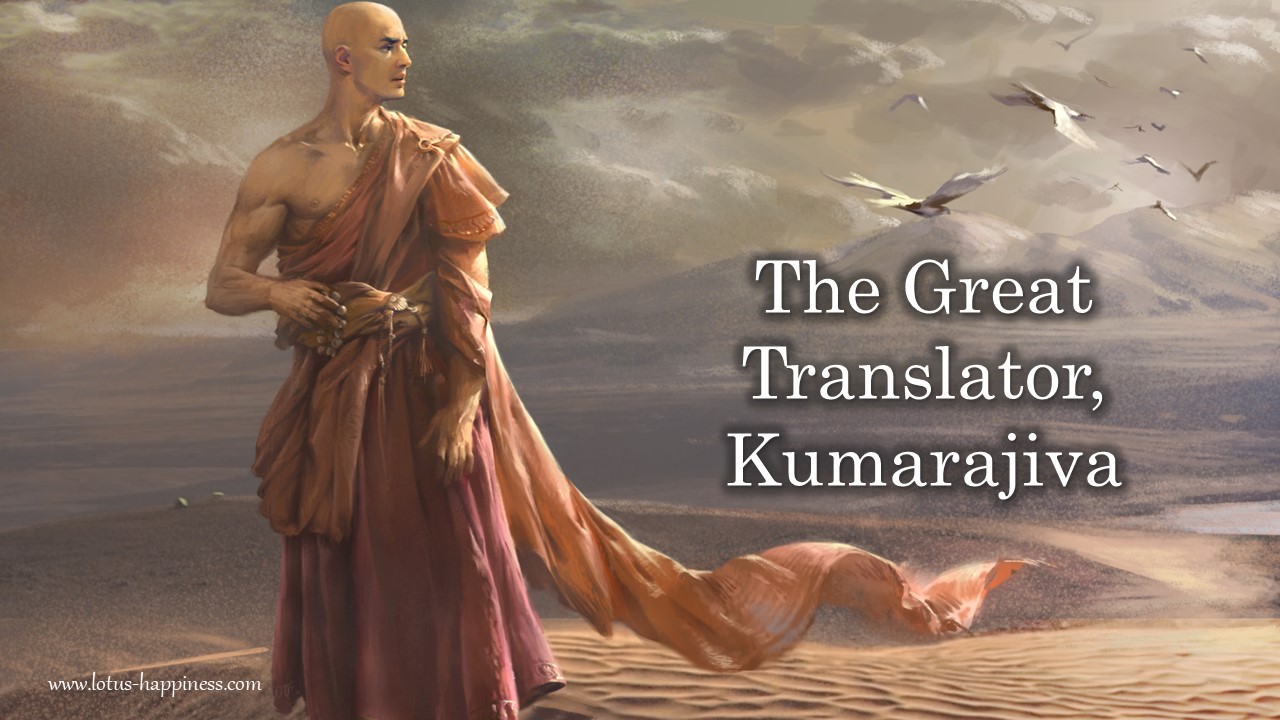Understanding Pure Land Sect (Part 1)
Pure Land is generally referred to as the Buddhaland. In Sanskrit, it is called Parisodhana-ksetra, which means the field that purifies. Each Buddha has his own Buddhaland. For instance, the Buddha of our world, known as Saha World, is Shakyamuni, while the Buddha of Eastern Lapis World is Bhaisajyaguru. However, the Pure Land sect as prevailed in China is commonly referred to the Western Paradise of Amitabha Buddha, known as Sukhavati. Sukhavati is a Sanskrit word, which means the most blissful of all paradises. In Sukhavati, there is no suffering, no evil paths (i.e. hell beings, ghosts and animals), no gender, in which the entire environment facilitates the attainment of Buddhahood.
In Chinese, Pure Land is pronounced as Ching Tu [淨土], so it is sometimes called Ching Tu sect.
In Japan, Pure Land sect is called Jodo.
Historical Development
Amongst all the Buddhist sects in China, Pure Land is the most popular one.
The Avatamsaka Sutra, the leading Sutra in Mahayana Buddhism, contains a section dedicated to Samantabhdra Bodhisattva and to his Ten Great Vows orientating sentient beings towards the rebirth in Pure Land. Thus Samantabhdra Bodhisattva should be the first patriarch of Pure Land sect.
Though there is no clear Indian background on the propagation and the transmission of the Pure Land tenets, Asvaghosa Bodhisattva recommends the recitation of Amitabha Buddha’s name in his treatise ‘Awakening of Faith‘, and urges the devotees to seek rebirth in the Western Pure Land. Nagarjuna Bodhisattva dedicated one chapter and twelve sections to the subject of easy practice, which highlighted one of the main characteristics of Pure Land sect. Vashubandhu Bodhisattva also wrote a treatise on Pure Land. All these writings propagate Pure Land from the Indian origin.
In China, the Pure Land sect began to flourish with Master Hui Yuan [慧遠] (334-416 AD) during the Eastern Chin [東晉] dynasty,. Though he had no intention to establish a Pure Land sect, he was perhaps the first to organize and give practice of reciting Buddha’s name by forming the ‘White Lotus Society’ [白蓮社] at Lu Shan [盧山] in Kiangsi province in 402 AD. This branch of Pure Land sect is sometimes called Lu Shan branch [盧山派].
Apart from Hui Yuan, Tan Luan [曇鸞] (476-542 AD) and Tzu Min [慈愍] (680-748 AD) were other branches in the development of Pure Land sect in China..
Tan Luan met the Indian monk Bodhiruchi who convinced him that the true immortality lay to be the devotion to Amitabha Buddha. He then advocated ‘Nien-fo’ [念佛], which has become one of the most popular practices in Chinese Buddhism.
In Sung dynasty, seven Pure Land patriarchs were selected by Hsiao Fa Shih and other great masters. The following were then recognized as the patriarchs in Pure Land sect:
- Hui Yuan [慧遠]
- Shan Tao [善導]
- Cheng Yuan [承遠]
- Fa Chao [法照]
- Shao Kang [少康]
- Yen Shou [延壽]
- Hsing Chang [省常]
Other patriarchs, such as Lien Chih [蓮池], Ou I [蕅益], and Yin Kuang [印光] were also remarkable masters in Pure Land sect in China.
Amongst them, Yen Shou and Lien Chih were two enlightened Chan masters, and they spread the Pure Land teaching for those who were not suitable or unable to awaken to the mind Dharma.
Three Branches of Pure Land Sect
Hui Yuan [慧遠] (334-416 AD)
The great master was regarded as the first patriarch of Pure Land sect in China, mainly because he founded the White Lotus Society in 402 AD.
He studied Confucianism and Taoism in his early years. When he was 21, he was converted to Buddhism, and became the brilliant disciple of Tao An [道安] (312-385 AD). He founded the Tung Lin Monastery [東林寺] on Lu Shan [盧山], to which he retired. The White Lotus Society inspired the followers with his virtues, teachings and strict codes of disciplines, which served as a model of the devotees in Pure Land sect later.
Hui Yuan, who was well versed with the study of Prajna [般若學], expounded the theory of emptiness [空觀] with reference to the writings of Nagarjuna. It serves to be the characteristic of Hui Yuan branch [慧遠派] of Pure Land sect in China.
Tan Luan [曇鸞] (476-542 AD)
He lived near Mount Wu Tai. In pursuing Taoism, he met the Buddhist monk Bodhiruchi, who taught him the texts of Pure Land sect. He was totally convinced, then he concentrated his effort on the rebirth of the Pure Land of Amitabha Buddha, and the propagation of the Pure Land tenets, particularly in northern China. The practice of reciting and meditating on the name of the Amitabha Buddha, probably originated with him.
By integrating the concepts of Real Mark [實相] and Dependent Origination [緣起] in Pure Land sect, Tan Luan established a new foundation in the development of Pure Land sect in China. It is known as Tan Luan branch [曇鸞派].
Tzu Min [慈愍] (680-748 AD)
Tzu Min was inspired by the stories of Amitabha Buddha and Avalokitesvara Bodhisattva during his stay in India during 704-716 AD. After he returned to China, he decided to dedicate his life to the propagation of the Pure Land tenets. He was granted a title of Tzu Min, which means ‘compassionate’ and ‘benevolent’, by the emperor. During his time, the meditation as taught by Hui Neng in Chan sect was very popular. However, Tzu Min advocated the sympathetic practice of ‘Nien Fo’ and Chan meditation [禪修] and he was considered to be the first to harmonize the Pure Land and Chan teachings [禪淨雙修]. It serves to be another branch in the development of Pure Land sect in China, known as Tzu Min branch [慈愍派].
Other Remarkable Patriarchs
Tao Cho [道焯] (562-645 AD)
The patriarch played a significant role in the spread of Pure Land teachings. He wrote many essays to describe how the lay people could enter the Pure Land during the Dharma ending age. The oral invocation of the name of Amitabha Buddha was the simplest answer. He asked his disciples to use beans as an aid in counting the number of times they recite the Buddha’s name. His essays were collected in the Collection of Essays on the Pure Land [安樂誌].
Shan Tao [善導] (613-681 AD)
He was one of the great and important Pure Land masters, who taught that men, steeped in ignorance and evil desire, have little power to save themselves. They must rely on faith in Amitabha Buddha alone, that guarantees to all who sincerely believe in him salvation and entrance into the Pure Land.
His principal work was the Commentary to the Sutra of Contemplation [觀經疏]. He pointed out the five main activities that could lead to the rebirth in Pure Land:
- Invoking the name of the Buddha
- Chanting the Sutras
- Meditating on the Buddha
- Worshipping images of the Buddha
- Praising to the Buddha
The first one was the primary one, while the other four were supplementary. He also wrote that this Buddha-remembrance or ‘Nien-fo’ practice could wash away the sins accumulated during eighty Kalpas. Because of the simplicity of this approach to rebirth in the Pure Land, it was appealing to many ordinary people.
Shan Tao is generally regarded as the first patriarch of Pure Land sect in Japan, as his disciple Fa Yin [法然] established Pure Land sect in Japan based on Shan Tao’s writings.
Fa Chao [法照]
Fao Chao was the disciple of Cheng Yuan [承遠] (712-804), who first studied Tien Tai and became the direct disciple of Tzu Min in Pure Land sect. By his time, there were other popular masters, such as Amoghaavajra [不空] in Tantric sect, Chan Jan [湛然] in Tien Tai sect, Cheng Kuan [澄觀] in Hua Yen sect. Fa Chao initiated the practice of Invoking the Name of Amitabha Buddha in Five Times [五會念佛], which he said was taught to him by Amitabha Buddha. During the reign of Tai Tsung [太宗], he was honored with the title of National Preceptor [國師].
Lien Chih [蓮池]
The great master Lien Chih of the Ming dynasty, who was first introduced to Pure Land by Hsiao Yen Chih, understood its significance and adopted in practice, feeling that Karma can be purified by recitation of the Buddha’s name, which complements and supports the practice of Chan meditation. Other masters such as Ou I [蕅益], Chih Liu [截流], Hsing An [省痷] and Meng Tung [夢東] followed him and practiced ‘Nien-fo’.
Principal Texts
There are three principal Sutras in Pure Land sect, known as the Three Sutras of Pure Land:
- Amitabha Sutra, or The Smaller Sukhavati-vyuha Sutra, [阿彌陀經]which describes the Pure Land of Amitabha Buddha
- Amitayus Sutra, or The Larger Sukhavati-vyuha Sutra, [無量壽經]which tells the story of Bhiksu Dharmakara, the former life of Amitabha Buddha, and his 48 great vows, which form the foundation of Sukhavati.
- Contemplation Sutra [觀無量壽經], which teaches the method of meditation by which the practitioners can be reborn in Sukhavati of Amitabha Buddha.
By adding the following two extracts, the five scriptures are known as the Five Sutras of Pure Land:
- Chapter on the Perfect Penetration of Mahasthamaprapta Bodhisattva [大勢至圓通章](in Shurangama Sutra)
- Discourse on Samantabhadra Bodhisattava’s Beneficence Aspiration [普賢行願品](in Avatamsaka Sutra)
By adding a treatise written by Vashubandhu Bodhisattva called ‘The Shastra on Pure Land’ [淨土論] to the above Three Sutras, it is called Three Sutras and One Shastra.












